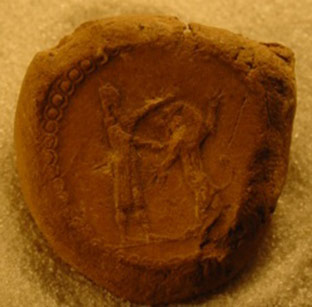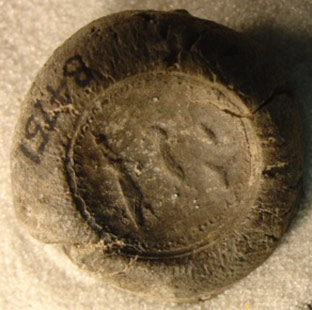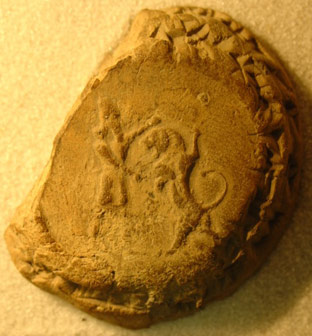The royal seal: a sign of the king's trust and a manifestation of royal authority
The motif of the Assyrian royal stamp seal, showing the king fighting a lion, was known throughout the empire and was closely identified with the king himself. Whoever held a copy of this seal, usually in the shape of a golden signet ring (unqu), was acting as the king's representative and on behalf of the king: his commands could not be refused.
A token of the king's trust

Together with clay tablets and the cuneiform script, seals were originally developed as instruments of the administration. Over time, they became omnipresent in the urban sphere, having gained secondary purposes in legal procedures, in long-distance communications and as talismans, to name but a few of the more prominent usages which are all well attested in the Neo-Assyrian period. Yet seals remained essential tools of the state administration and played an important role in the Assyrian king's delegation of power to his officials.
Hundreds of copies of the royal seal were in circulation at any one time and we can assume that each state official of a certain rank held one. A letter to Esarhaddon (681-669 BC) explicitly mentions how royal seals were handed out to the king's new representatives in Babylonia: "(Concerning) the message which the king, the lord, sent and the golden signet rings which they gave to me, saying: 'Send them to Babylon!' One signet ring I have already given to Mušezib-Marduk but the signet ring for Šuma-iddin, the prelate of Der, is still with me" (SAA 18 163).
Today, the Assyrian royal seal type is attested in at least 104 known individual examples, of different sizes and minute differences in design, which were in use over a span of roughly two centuries: a cuneiform label inscribed on the clay sealing dates the earliest specimen to the reign of Shalmaneser III (858-824 BC). While no original seal survives - which is not surprising given that they were made out of gold and are therefore likely to have been melted down at some point when they were no longer of practical use - hundreds of seal impressions are attested on clay tablets and on clay sealings which were originally affixed to various containers or writing tablets. The bearer of a royal seal acted as the representative of the king who had issued the seal to him: when a royal official impressed the royal seal he acted for the king and as the king, and not as the current holder of his specific office. But the official did not need to impress the seal. Simply by being in possession of the royal seal, he was able to issue commands in the king's stead and on the king's behalf.
The royal stamp seal, as a token of the king's trust and a manifestation of royal authorisation, was an innovation of the Neo-Assyrian period which coincided with Assyria's transformation from kingdom to empire. It was an administrative technology developed to run the swiftly expanding state, intimately connected to the need to delegate power from the king to his officials while at the same time stressing that whoever used the seal was acting not on his own personal authority but on authority vested in him by the king. From the 8th century BC onwards, there are also other such "bureau seals" in use, representing specific administrative institutions such as the household of individual governors and, later on, also of the queen and the crown prince.
As good as the word of the king himself

Any document bearing the impression of the royal seal was as good as a direct command of the king and forced his subjects to act accordingly. This is made very clear by the way a provincial governor makes his excuses to Sargon II (721-705 BC) for being late for the muster of troops. Executing the king's orders is what prevents his departure: "The cohort commander Išme-ili is bringing us a (document sealed with the) golden signet ring of the king and continues to delay us, saying: 'Transport barley to Mazamua!'" (SAA 5 234). Whether the text in question is a specific letter or an administrative document confirming a general tax obligation, being authorised with the royal seal it could not possibly be ignored unless the king said otherwise, and the mention of the fact that the royal signet ring is golden seems to serve no other purpose than to emphasise this.
A similar excuse is used by a Babylonian subject of king Esarhaddon after failing to show up for an oath ceremony: "I was not present (because of) the (order sealed with the) signet ring of the king, my lord, which Aššur-ra'im-šarri delivered to me: As my brothers and I had to go with him to Araši to keep the watch (at the Elamite border) I missed the appointment of the oath of Babylon" (SAA 18 162).
Conversely, orders that were not backed up by an impression of the royal bureau seal were easily refused, as one of Esarhaddon's officials in Babylonia came to experience: "Concerning the fugitive scholars, eunuchs and soldiers of Šamaš-ibni [the leader of Bit-Dakkuri, an enemy of Assyria], who are (now) with Nabû-ušallim, about whom the king, my lord, wrote to me: When I spoke to him, he refused to give them to me, saying: 'I will not give them to you in the absence of a (document sealed with the) signet ring of the king and a member of the royal entourage!'" (SAA 18 56).
A forgery or a ploy to buy time?

Orders not carrying the royal seal could be easily refused and the same was true if the seal was suspected of not being genuine. A letter from the Sargon correspondence records the reaction of an official who had received a letter order authenticated with a seal impression which he refused to accept as the real thing:
"The signet ring (impression on the letter) which he delivered is not made like the signet rings of the king, my lord. I have a thousand signet ring(-sealed letter)s of the king, my lord, with me and I have compared it with them - it is not made like the signet ring of the king, my lord! I am herewith sending the signet ring(-sealed letter) to the king, my lord. If it is genuine, let them write a copy of the signet ring(-sealed letter) which I am sending and I will place it with him, so that he may go where the king, my lord, sent him to" (SAA 15 125).
The official's claim to be the recipient of a thousand royal letters may be overstated but he certainly knew what an impression of the royal seal looked like and was not prepared to follow instructions which could not be verified as authorised by the king. What we cannot know, however, is whether this was indeed a case of bold forgery or false alarm, raised perhaps with the intention of buying time before having to comply with an unpopular order.
Further reading:
Radner, 'The delegation of power', 2008.
Content last modified: 5 Nov 2012.
Karen Radner
Karen Radner, 'The royal seal: a sign of the king's trust and a manifestation of royal authority', Assyrian empire builders, University College London, 2012 [http://www.ucl.ac.uk/sargon/essentials/governors/theroyalseal/]